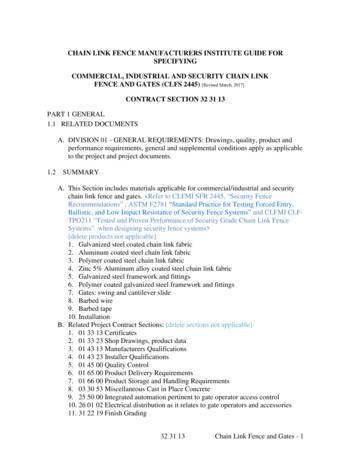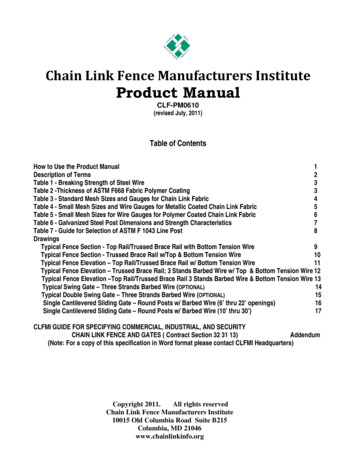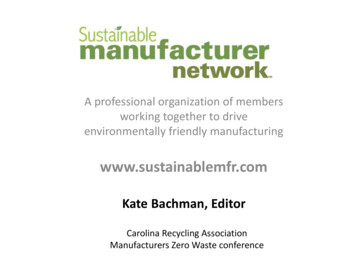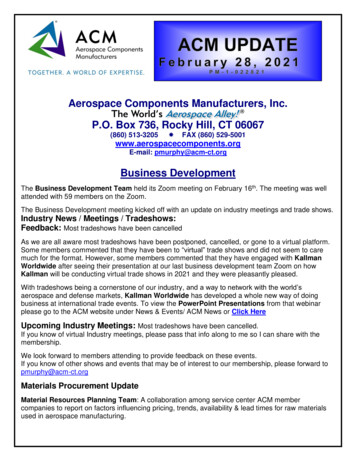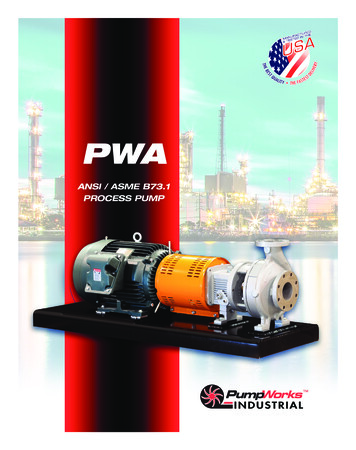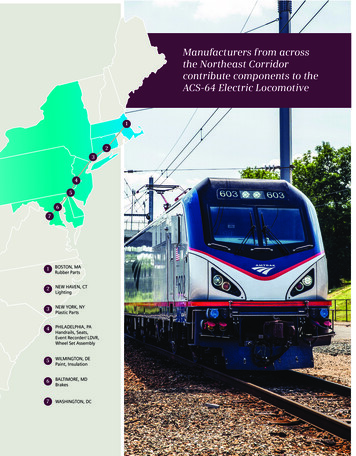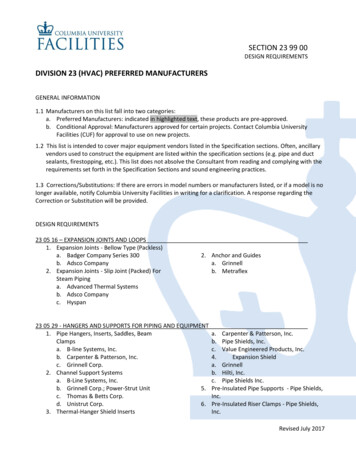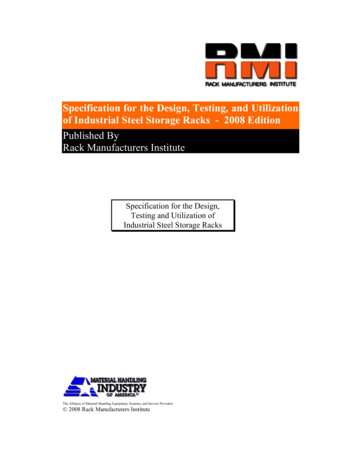
Transcription
Specification for the Design, Testing, and Utilizationof Industrial Steel Storage Racks - 2008 EditionPublished ByRack Manufacturers InstituteSpecification for the Design,Testing and Utilization ofIndustrial Steel Storage RacksThe Alliance of Material Handling Equipment, Systems, and Service Providers 2008 Rack Manufacturers Institute
2008 RMI SpecificationRevision 2.0Feb. 26, 2008Page iPREFACERACK MANUFACTURERS INSTITUTEThe Rack Manufacturers Institute (RMI) is an independent incorporated trade associationaffiliated with the Material Handling Industry. The membership of RMI is made up ofcompanies which produce the preponderance of industrial steel storage racks.RMI maintains a public website at www.MHIA.org/RMI that has information about storageracks and the RMI members including ordering information for literature and a section forfrequently asked questions. All inquiries concerning the Specification should be directed inwriting to the RMI Engineering Committee, 8720 Red Oak Boulevard, Suite 201, Charlotte,NC 28217MATERIAL HANDLING INDUSTRYThe Material Handling Industry (Industry) provides RMI with certain services and, inconnection with this Specification, arranges for its production and distribution. Neither theMaterial Handling Industry nor its officers, directors, or employees have any otherparticipation in the development and preparation of the information contained in theSpecification.SPECIFICATION - HISTORYIn the interest of improved uniformity of rack performance and enhanced public safety, theRMI published in 1964 its first “Minimum Engineering Standards for Industrial StorageRacks.” and now publishes this Specification. It was developed and promulgated by the RMIwith the sole intent of offering information to the parties engaged in the engineering,manufacturing, marketing, purchasing, installation or use of such racks.Since 1964, mechanized storage systems have grown very rapidly both in size and heightwith new and modified types of racks having been developed. To reflect this rapiddevelopment and to assure adequate safety and performance of modern rack structures, theRMI decided early in 1971 to replace its original standards by a more detailed andcomprehensive specification. Professors George Winter and Teoman Pekoz of CornellUniversity were retained to assist the Rack Standard Development Project Committee inproducing such a document. The members of the Material Handling Institute, Inc. were thesponsors.In 1972, the “Interim Specification for the Design, Testing and Utilization of Industrial SteelStorage Racks” was adopted by the Rack Manufacturers Institute at their annual fall meeting.The specification was then submitted to the American National Standards Institute for theirreview and acceptance. In 1974, the Interim Specification with minor changes was acceptedas American National Standard ANSI MH 16.1-1974.The Rack Manufacturers Institute together with its sponsors from the Material HandlingInstitute, Inc., retained Professors Winter and Pekoz to continue testing rack components plusperform full scale tests on typical storage rack structures. A number of the test results have
2008 RMI SpecificationRevision 2.0Feb. 26, 2008Page iibeen analyzed, and it was considered necessary to rewrite the 1972 Interim Specification toinclude the knowledge gained from the analysis of those tests. The 1972 InterimSpecification was rewritten by the Rack Standards Subcommittee with the assistance ofProfessors Winter and Pekoz. Design parameters relating to drive-in and drive-through rackshave been removed from the Specification until drive-in and drive-through rack test resultscould be analyzed more thoroughly; perhaps more testing would be required. Movable-shelfracks were added to the Specification.As a result of additional testing and analytical research, the RMI revised the 1972Specification. The ANSI MH 16.1-1974 was withdrawn in deference to the 1979Specification. More additions and revisions prompted the RMI to publish the 1985Specification.Subsequent testing and research by Dr. Pekoz was the basis of the changes resulting in the1990 Specification.From 1990 to 1997, due to continuing changes, specifically as they relate to seismic analysisand other model building code issues, the Specification Advisory Committee, the SeismologyCommittee and the RMI Engineering Committee working again with Dr. Pekoz and severalhighly regarded members of the code community and various other members of similargroups throughout the world, conducted extensive testing and parametric analysis. Findingsresulted in the 1997 Specification.In addition to the state-of-the-art benefit from the ongoing testing and analysis, the 1997Specification was expanded to include complete treatment of seismic design considerationsso that the Specification could be more easily incorporated by reference into various modelbuilding and design codes.In 1999, the Membership of RMI acted to create a Voluntary Certification Program known asthe R-MARK. The R-Mark is a license earned by a manufacturer following a rigorous reviewby Independent Professional Engineers of tests and load capacity calculations performed bythe manufacturer consistent with the RMI/ANSI Specification.Continued testing and parametric studies resulted in the 2002 Specification. In 2004 the 2002RMI Specification and Commentary were adopted as American National StandardANSI MH 16.1-2004SPECIFICATION - 2008 EDITIONThe use of this Specification is permissive, not mandatory. Voluntary use is within thecontrol and discretion of the user and is not intended to, and does not in any way limit theingenuity, responsibility or prerogative of individual manufacturers to design or produceindustrial steel storage racks that do not comply with this Specification. RMI has no legalauthority to require or enforce compliance with the Specification. This advisorySpecification provides technical guidelines to the user for his specific application. Followingthe Specification does not assure compliance with applicable federal, state, or localregulations and codes. This Specification is not binding on any person and does not have theeffect of law.The RMI and the Material Handling Industry do not take any position regarding any patentrights or copyrights which could be asserted with regard to this Specification and does notundertake to insure anyone using this Specification against liability, nor assume any such
2008 RMI SpecificationRevision 2.0Feb. 26, 2008Page iiiliability. Users of this Specification are expressly advised that determination of the validityof any such copyrights, patent rights, and risk of infringement of such rights is entirely theirown responsibility.In the interest of safety, all users of storage racks are advised to regularly inspect andproperly maintain the structural integrity of their storage rack systems by assuring properoperational, housekeeping and maintenance proceduresUsers of the Specification must rely on competent advice to specify, test and/or design thestorage rack system for their particular application. This Specification is offered as aguideline. If a user refers to, or otherwise employs, all or any part of the Specification, theuser is agreeing to follow the terms of indemnity, warranty disclaimer, and disclaimer ofliability.DisclaimerThis standard, which was developed under Material Handling Industry procedures on2/26/08, represents suggested design practices and performance testing criteria for industrialsteel storage racks. It was developed with the sole intent of offering information to partiesengaged in the manufacture, marketing, purchase, or use of industrial steel storage racks.This standard is advisory only and acceptance is voluntary and the standard should beregarded as a guide that the user may or may not choose to adopt, modify, or reject. Theinformation does not constitute a comprehensive safety program and should not be reliedupon as such. Such a program should be developed and an independent safety adviserconsulted to do so.Material Handling Industry (MHI), Rack Manufacturers Institute (RMI) and their membersassume no responsibility and disclaim all liability of any kind, however arising, as a result ofacceptance or use or alleged use of this standard. User specifically understands and agreesthat MHI, RMI and their officers, agents, and employees shall not be liable under any legaltheory or any kind for any action or failure to act with respect to the design, erection,installation, manufacture, preparation for sale, sale, characteristics, features, or delivery ofanything covered by this standard. Any use of this information must be determined by theuser to be in accordance with applicable federal, state, and local laws and regulations.MHI and RMI make no warranties of any kind, express, implied, or statutory, in connectionwith the information in this standard. MHI and RMI specifically disclaim all impliedwarranties of merchantability or of fitness for particular purpose.By referring to or otherwise employing this standard, the user agrees to defend, protect,indemnify, and hold MHI and RMI and their officers, agents, and employees harmless fromand against all claims, losses, expenses, damages, and liabilities, direct, incidental, orconsequential, arising from acceptance or use or alleged use of this standard, including loss ofprofits and reasonable attorneys' fees which may arise out of the acceptance or use or allegeduse of this standard. The intent of this provision and of the user is to absolve and protectMHI and RMI and their officers, agents, and employees from any and all loss relating in anyway to this standard, including those resulting from the user's own negligence.
2008 RMI SpecificationRevision 2.0Feb. 26, 2008Page ivTABLE OF CONTENTS1.2.GENERAL .11.1SCOPE.11.2MATERIALS. .11.3APPLICABLE DESIGN SPECIFICATIONS.11.4INTEGRITY OF RACK INSTALLATIONS.11.4.1Owner Maintenance.11.4.2Plaque .21.4.3Conformance.21.4.4Load Application and Rack Configuration Drawings .21.4.5Multiple Configurations.21.4.6Movable-Shelf Rack Stability.31.4.7Column Base Plates and Anchors.31.4.8Small Installations .31.4.9Rack Damage .31.4.10Racks Connected to the Building Structure .31.4.11Out-of-plumb and Out-of-straight Limits .3LOADING .42.1LOAD COMBINATIONS FOR THE ASD DESIGN METHOD .42.2LOAD FACTORS AND COMBINATIONS FOR THE LRFD DESIGN METHOD .52.3VERTICAL IMPACT LOADS.52.4HORIZONTAL FORCES.62.5WIND LOADS.62.6EARTHQUAKE LOADS .72.6.1General .72.6.2Minimum Seismic Forces.72.6.3Calculation of Seismic Response Coefficient.82.6.4Connection Rotational Capacity.192.6.5Seismic Displacement .192.6.6Vertical Distribution of Seismic Forces.192.6.7Horizontal Shear Distribution .202.6.8Overturning.20
2008 RMI SpecificationRevision 2.02.6.9Feb. 26, 2008Page vConcurrent Forces .203.DESIGN PROCEDURES .214.DESIGN OF STEEL ELEMENTS AND MEMBERS .214.1COLD-FORMED STEEL MEMBERS {THE AISI (2001) [1] SECTION C} .214.1.1Properties of Sections {The AISI (2001) [1] Section C1}.214.1.2Flexural Members {The AISI (2001) [1] Section C3}. .214.1.3Concentrically Loaded Compression Members. {The AISI (2001) [1]Section C4}. .
as American National Standard ANSI MH 16.1-1974. The Rack Manufacturers Institute together with its sponsors from the Material Handling Institute, Inc., retained Professors Winter and Pekoz to continue testing rack components plus
